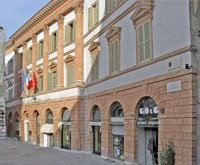
The Trinci lords occupied a number of buildings in Foligno in the 14th century, including the Palazzo dei Canonici and Palazzetto del Podesta. Towards the end of the century, Ugolino III Trinci (1386 - 1415) acquired a number of palaces at the far end of what is now the Piazza del Repubblica, in order to build this imposing residence, which is referred to in documents as "domus novas magnifici domini Ugolini".
Parts of the original palaces on the site were retained, which accounts for the irrational layout of the building:
The oldest parts of the structure, which are on the ground floor, seem to date to the mid 14th century.
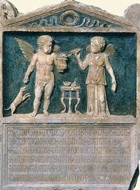
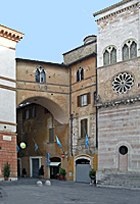
-
✴one, which was demolished in the 18th century, spanned what is now Via Antonio Gramsci on the left, to Palazzetto del Podesta; and
-
✴the other, which still survives, spanned what is now Via XX Settembre on the right (illustrated here) and continued behind the minor facade of the Duomo to Palazzo dei Canonici. This corridor can be visited from the palace and part of it is now incorporated into the Museo Diocesano.
The only work that was definitely carried out after Ugolino's death dates to 1424, when Corrado Trinci become the sole ruler of Foligno after the murder of his brothers: a surviving inscription records that he commissioned the frescoes in the chapel.
After the execution of Corrado Trinci in 1439, when Foligno passed under papal domination, Cardinal Giovanni Vitelleschi requisitioned the palace and it was used for the residence of the papal governor and the priors. It began to decline from this point, despite restorations under a succession of popes:
-
✴Pope Pius II in 1458;
-
✴Pope Sixtus IV, after an earthquake in 1477; and
-
✴Pope Paul III in 1546.
Subsequent developments led to the loss of much of the original character of the building:
-
✴One wing of the palace was adapted for use as a prison in 1578.
-
✴A small theatre was installed in another wing in the 18th century.
-
✴It was damaged in the earthquake of 1832 (see below).
-
✴Part of the rear of the palace was destroyed in the bombardment of 1944.
Facade
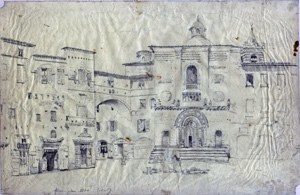
Piazza Grande, Foligno
Sketch (1840) signed by Edmond Du Sommerard, Museo della Città
(I am grateful to the Comune di Foligno for kindly supplying this image)
This engraving shows the appearance of Palazzo Trinci (to the left) before its restoration, when its facade clearly reflected its heterogenous architectural history. The present façade (Illustrated at the top of the page), which unifies these diverse structures, was built in 1842-7 to a design that was developed by Odoardo Poggi and Sigismondo Ferretti and finalised by Vincenzo Vitali.
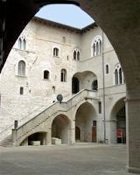
Sarcophagi (ca. 500 AD)
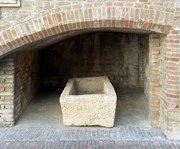
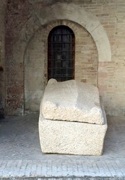
These two sarcophagi are under the arches of the external staircase. According to Matelda Albanesi (referenced below, 2014, at p, 562-3 and notes 11 and 12):
-
✴one of them (I think this was the one on the right) was found in Via Rubicone in 1987; and
-
✴the other came from San Feliciano di Mormonzone.
Luigi Sensi (referenced below, 1982) described a third sarcophagus which was discovered in the late 19th century at an unspecified location near Santa Maria in Campis and which survived in this courtyard until 1944. These sarcophagi are discussed in my page on Roman Walk II.
Internal Layout
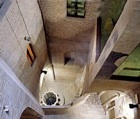
This staircase abuts a three-storey tower that houses the chapel on its top floor. The loggia beside it served as an entrance to the public area on the piano nobile of the palace. Many of the rooms on this floor still contain important frescoes.
-
✴The piano nobile also accommodates:
-
•the Trinci collection of ancient artefacts; and
-
•four rooms of the Pinacoteca Civica.
-
✴A further four rooms of the Pinacoteca Civica are adjacent to the ticket office.
-
✴So too are four rooms of the Museo Archeologico.
-
•Another two rooms of the Museo Archeologico are on the mezzanine below; while
-
•a further three are at the foot of the Gothic staircase.
Directions to these rooms of the museums are given in the respective pages.
Read more:
M. Albanesi, “Indagini a Santa Maria in Campis di Foligno: una Fase Tardoantica a Fulginia”, Bollettino Storico della Città di Foligno, 37 (2014) 559-66
G. Benazzi and F. Mancini (Eds), “Il Palazzo Trinci di Foligno”, (2001) Perugia
L. Sensi, “Un Sarcofago Paleocristiano da Santa María in Campis”, Bollettino Storico della Città di Foligno, 6 (1982) 19-34
Proceed to: Chapel Piano Nobile.
Return to the page on Monuments of Foligno.
Return to Walk II.



